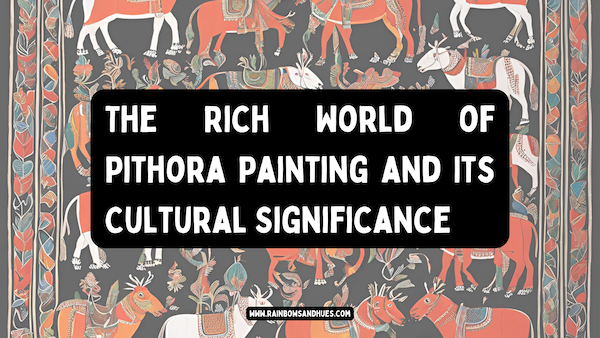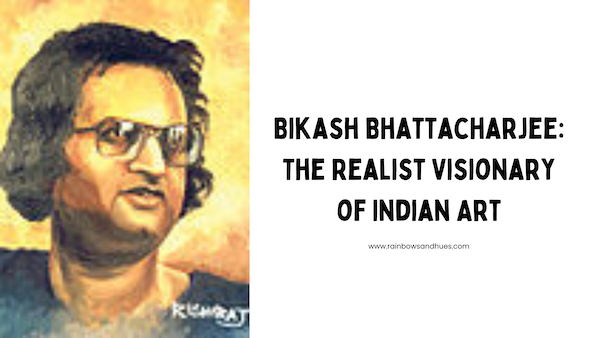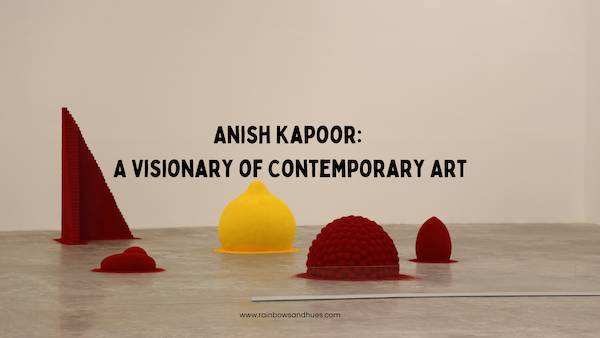In the heart of central India, among the indigenous communities, lies a unique art form that’s as vibrant as it is ancient: Pithora painting. This traditional Indian tribal art, primarily practiced by the Rathwa, Bhil, and Bhilala tribes in Gujarat and Madhya Pradesh, is much more than a form of decoration. It represents centuries-old beliefs, stories, and the spiritual essence of its people. Pithora painting is known for its bold colors, intricate designs, and deeply spiritual motifs, but its true beauty lies in the meaning and rituals woven into each brushstroke.
Also Read: Pattachitra: A Window into Ancient Indian Folk Art
In this post, we’ll dive into the origins of Pithora painting, its symbolism, and the techniques involved in creating one of these vivid works of art. This traditional craft not only enhances the beauty of homes but also brings blessings and fulfills cultural duties, making it a unique bridge between art and spirituality.
Origins of Pithora Painting: A Sacred Tradition
The origins of Pithora painting date back centuries, with deep roots in the customs of the Rathwa, Bhil, and Bhilala tribes. These tribes view Pithora as more than art; it’s a ritualistic practice to honor their deity, Baba Pithora, the god of agriculture and the protector of the community. Traditionally, these paintings were created as a form of prayer, intended to bring blessings of prosperity, fertility, and good health.
Pithora paintings are often made on the walls of houses as part of a ritual that usually involves a priest, or Badwa, who leads the ceremonies. Families commission these paintings when they wish to celebrate significant milestones or when they’re facing a challenging situation and seek divine intervention. For example, it’s common for these paintings to be created to seek blessings for a good harvest, for the well-being of a child, or to safeguard against misfortunes.
Also Read: Alcohol Ink Art: An Exhaustive Guide
The Symbolism and Elements of Pithora Paintings
Every element in a Pithora painting has meaning. The paintings are typically divided into panels filled with animals, deities, people, and scenes from daily life, all of which are deeply symbolic. Some of the key elements include:
- The Horses and Riders: Horses, often accompanied by riders, are a prominent motif in Pithora paintings. They represent the gods and goddesses, especially Baba Pithora, who is often depicted riding a horse. Each horse is painted with distinctive details, signifying different aspects of nature and spiritual power.
- Sacred Animals and Birds: Different animals such as peacocks, cows, and elephants are common in Pithora art, symbolizing nature and harmony. These animals hold special meaning, representing prosperity, strength, and divinity.
- The Sun and Moon: The celestial symbols in Pithora art signify the eternal cycle of life and the interconnectedness of all beings with the universe.
- People and Villages: Scenes of villagers working, dancing, or celebrating are also common and reflect the daily lives and festivities of the tribal communities. These scenes show a close connection with nature and the community’s respect for the land.
The paintings typically use seven colors—black, red, yellow, green, blue, white, and orange—all of which have ritualistic significance. White is particularly sacred and is often used as a base, symbolizing purity and the divine connection of the artwork.
Also Read: Unraveling the Enchanting World of Gond Art
How to Create a Pithora Painting: Step-by-Step Guide
Creating a Pithora painting is not only a skilled artistic process but also a ritualistic one. Here’s how the traditional process typically unfolds:
- Preparation of the Wall: Pithora paintings are often created on freshly plastered mud walls. A coat of white paint, made from rice flour or chalk powder, is applied as a base layer, symbolizing purity and readiness for the divine figures.
- Drawing the Outline: After the base is prepared, the artist, called a Lakhara, draws outlines of various figures and motifs using a blend of black or red paint. The artist usually begins with the horses and riders, who represent the deities and central characters.
- Filling in Colors: Once the outline is complete, the artist begins to fill in each section with color. Natural colors made from locally available materials, like tree bark, leaves, and stones, are traditionally used. The use of natural pigments adds an earthy, authentic quality to the painting.
- Adding Details and Symbols: The artist then paints in details like facial expressions, decorative elements on the horses, and attire for the characters. Each element is given careful attention, as every detail is seen as a mark of respect for the deities.
- Final Blessing: After the painting is complete, a Badwa performs rituals to bless the artwork, inviting prosperity and health into the household. This final step transforms the Pithora painting from an artwork into a sacred object.
Also Read: Incorporating Dried Flowers in Resin Art: A Guide
Famous Artists and the Revival of Pithora Art
Several Pithora artists have received national and international acclaim for their efforts in preserving and promoting this traditional art form. Among them is Lado Bai, a celebrated Bhil artist from Madhya Pradesh, whose works have gained recognition for their vibrancy and authenticity. Another prominent artist is Bhuri Bai, who has worked tirelessly to bring Bhil art, including Pithora painting, to the global stage.
With increased interest in indigenous art, organizations and art collectors around the world are helping revive Pithora painting. Artists now often adapt the tradition to canvas and paper, allowing the art form to reach a broader audience without compromising its authenticity.
Unknown Facts About Pithora Art
- Ritual Restrictions: Traditionally, Pithora paintings could only be created by men within the community, as it was believed that women painting these symbols could disrupt their sacredness. However, with modernization, many women are now celebrated Pithora artists.
- Natural Ingredients: In ancient times, the colors used in Pithora paintings came from natural sources like clay, leaves, and even cow’s urine, which were prepared according to secret tribal recipes.
- Three-Wall Display: In traditional Pithora painting, the artwork would cover three walls of a room, forming a panoramic view of the community’s relationship with the divine.
Also Read: A Comprehensive Guide to Chalk Paints
Pithora Painting in the Global Art Scene
Today, Pithora art has found a place not only in Indian homes but also in international galleries. Art enthusiasts and collectors from around the world appreciate the paintings for their cultural richness, intricate designs, and spiritual depth. Some Western galleries have started displaying Pithora paintings, highlighting the vibrant history and cultural significance of tribal art.
While some modern adaptations of Pithora painting can now be found on canvas, cushions, and other home décor items, many still appreciate the traditional form for its authenticity and spiritual value.
Conclusion: Embracing Pithora Art at Home
Incorporating Pithora paintings into your space is a way of inviting tradition, spirituality, and beauty into your home. Whether you decide to commission a traditional artist or explore it yourself as a DIY project, learning about the art form and understanding its significance adds depth to your appreciation.
As you create or select a Pithora painting for your home, remember it’s more than just art; it’s a connection to a rich heritage, a celebration of life’s abundance, and a tribute to the enduring beauty of indigenous culture.
Also Read: Lippan Art: A Unique Blend of Tradition and Craftsmanship
***
Hop over to our website www.rainbowsandhues.com to explore exciting offers on arts & craft supplies on our website! Follow @rainbowsandhues on Instagram to get regular information on new products and deals!




